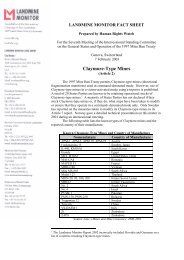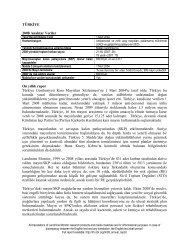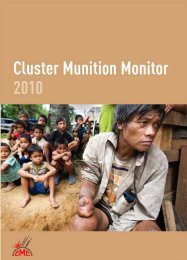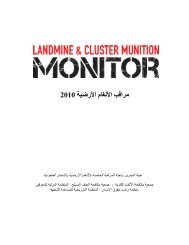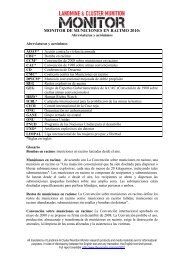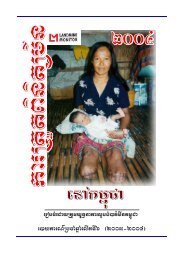Download PDF - Landmine and Cluster Munition Monitor
Download PDF - Landmine and Cluster Munition Monitor
Download PDF - Landmine and Cluster Munition Monitor
Create successful ePaper yourself
Turn your PDF publications into a flip-book with our unique Google optimized e-Paper software.
Contamination <strong>and</strong> Clearance<br />
State/area Estimated extent of contamination (km 2 )<br />
Nagorno-Karabakh 70.9 Approx. 250**<br />
Lebanon 17.86 449<br />
Serbia 17.58 386<br />
BiH 12.3 669<br />
Mauritania 9.0 (2 of 5 areas) 5<br />
Afganistan 7.64 22<br />
Croatia 7.3 Not reported<br />
Western Sahara 3.88 23<br />
Number of confirmed <strong>and</strong> suspected<br />
hazardous areas<br />
Note: Convention on <strong>Cluster</strong> <strong>Munition</strong> States Parties <strong>and</strong> signatories are indicated by bold <strong>and</strong> other areas by italics.<br />
* Partial results as survey is ongoing. ** Information as of 2011<br />
States Parties<br />
Ten States Parties are contaminated by cluster munition remnants, with the heaviest contamination to be found in Lao<br />
PDR <strong>and</strong> Lebanon:<br />
• Afghanistan has a threat from cluster munition remnants primarily from use of air-dropped <strong>and</strong> rocket-delivered<br />
submunitions by Soviet forces, while US aircraft used 1,228 cluster munitions containing some 248,056<br />
submunitions between October 2001 <strong>and</strong> early 2002.10 Demining operators continue to encounter both US<br />
<strong>and</strong> Soviet-era cluster munition remnants.11 Afghanistan’s Mine Ban Treaty Article 5 deadline extension<br />
request, submitted in March 2012, lists 22 areas that remain contaminated by unexploded submunitions covering<br />
a total area of 7.64km². 12<br />
• BiH is contaminated with cluster munition remnants, primarily as a result of the 1992–1995 conflict related<br />
to the break-up of the Socialist Federal Republic of Yugoslavia. Yugoslav aircraft dropped BL 755 cluster<br />
munitions in the early stages of the conflict <strong>and</strong> states participating in NATO military action subsequently<br />
used cluster munitions. 13 A general survey completed by NPA in June 2011 identified 140 areas hit by air<br />
strikes <strong>and</strong> artillery resulting in an estimated total of 3,774 unexploded submunitions <strong>and</strong> additional contamination<br />
around a former ammunition factory at Pretis that was hit by a NATO air strike. The survey resulted<br />
in a significantly higher estimate of contamination of 669 suspect hazardous areas (SHAs) covering a total<br />
of more than 12km 2 . 14<br />
• Chile informed States Parties in April 2012 that it has military testing/training areas that are contaminated<br />
by cluster munition remnants, but provided no further details. 15 As of 31 July 2012, Chile still had not provided<br />
an initial Article 7 transparency report for the Convention on <strong>Cluster</strong> <strong>Munition</strong>s, originally due by 28<br />
November 2011.<br />
• Croatia has areas contaminated by cluster munition remnants left over from the conflict in the 1990s. In April<br />
2012, Croatia stated that 7.3km 2 of cluster-munition contaminated area remains, of which 4.7km 2 is classified<br />
as hazardous area containing cluster munition remnants only. Croatia has estimated that 5,500 submunitions<br />
remain to be cleared. 16<br />
• Germany announced in June 2011 that it had identified areas suspected of containing cluster munition remnants<br />
at a former Soviet military training range at Wittstock in Br<strong>and</strong>enburg. 17 The remnants were “principally<br />
found within the confines of a target range,” in the south of the training range covering an SHA of some<br />
4km 2 . 18 Germany reported the contamination in its annual Article 7 transparency report provided in 2012. 19<br />
10<br />
Human Rights Watch <strong>and</strong> <strong>L<strong>and</strong>mine</strong> Action, Banning <strong>Cluster</strong> <strong>Munition</strong>s: Government Policy <strong>and</strong> Practice (Ottawa: Mines Action Canada,<br />
May 2009), p. 27.<br />
11<br />
Interviews with demining operators, Kabul, 12–18 June 2010. In 2009, HALO cleared 2,607 unexploded submunitions. Emails from Ollie<br />
Pile, HALO, Kabul, 30 June 2009; <strong>and</strong> from Tom Dibb, HALO, 3 June 2010.<br />
12<br />
Afghanistan Mine Ban Treaty Article 5 deadline Extension Request, undated but submitted on 29 March 2012, p. 165.<br />
13<br />
NPA, “Implementation of the Convention on <strong>Cluster</strong> <strong>Munition</strong>s in Bosnia <strong>and</strong> Herzegovina,” Sarajevo, undated but 2010, provided by email<br />
from Darvin Lisica, Programme Manager, NPA, 3 June 2010.<br />
14<br />
NPA, <strong>Cluster</strong> <strong>Munition</strong>s Remnants in Bosnia And Herzegovina: A General Survey of Contamination <strong>and</strong> Impact, Draft Report, August 2011.<br />
Previously, in 2009, NPA had estimated that cluster munitions affected only 1–2km 2 .<br />
15<br />
Statement of Chile, Convention on <strong>Cluster</strong> <strong>Munition</strong>s Intersessional Working Group on Clearance <strong>and</strong> Risk Reduction, Geneva, 17 April 2012.<br />
16<br />
Statement of Croatia, Convention on <strong>Cluster</strong> <strong>Munition</strong>s Intersessional Working Group on Clearance <strong>and</strong> Risk Reduction, Geneva, 17 April<br />
2012.<br />
17<br />
Statement of Germany, Mine Ban Treaty St<strong>and</strong>ing Committee on Mine Action, Mine Risk Education <strong>and</strong> Mine Action Technologies, Geneva,<br />
21 June 2011.<br />
18<br />
Statement of Germany, Convention on <strong>Cluster</strong> <strong>Munition</strong>s Intersessional Meetings, Session on Clearance <strong>and</strong> Risk Reduction, Geneva, 28<br />
June 2011.<br />
19<br />
Germany, Convention on <strong>Cluster</strong> <strong>Munition</strong>s Article 7 Report (for calendar year 2011), Form F, 30 April 2012. In contrast to the rest of the<br />
report, the information in Form F is stated to be for the period from 1 August to 31 December 2011.<br />
43



